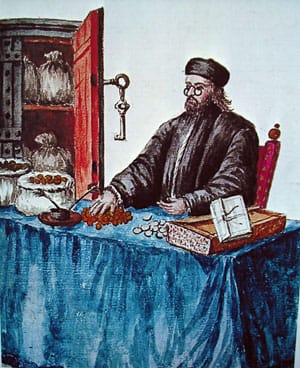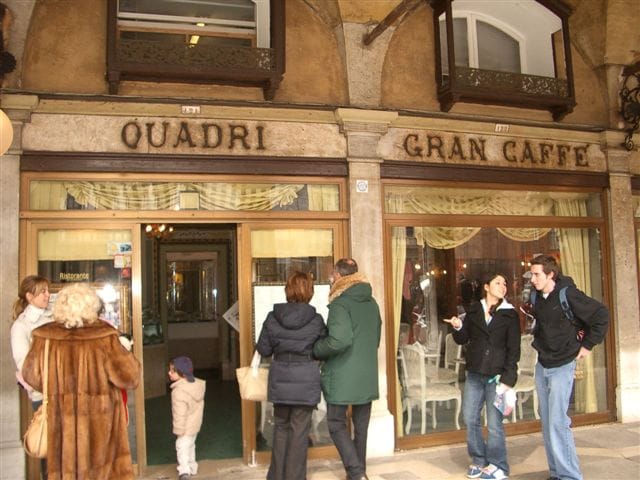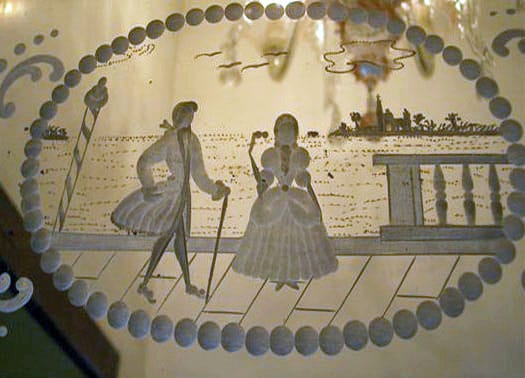Southern route (violet)
The southern route connects two different accesses to the city: the new and the old, following a route which is almost unknown to tourists.
Start from the left corner at Piazzale Roma, and walk along the very long Fondamenta dei Tre Ponti, heading to Accademia. Then walk along Calle Ragusei.
As you get to Campo dei Carmini, just turn left, passing Fondamenta del Soccorso and then Fondamenta di San Sebastiano, to get to the homonymous church. In its chapel of the Annunciation were originally kept the tiles representing the glasses. These tiles are now kept, as we saw on N route, at Ca’ d’oro. Right in front of the church you can see Calle dell’Avogaria. Walk down this street and then Calle Lunga San Barnaba, until you get to Ca’ Rezzonico, which is a museum since the 18th century, a big mansion on the grand canal times before. There are just a few glasses represented in the paintings in there, and not very important also. But the two globes and the furnishings of an old pharmacy, kept on the first floor, are worthy a visit.
It is time to go back to Campo San Barnaba. Now pass the Sotoportego del Casin dei Nobili, and walk over the following bridge. Just approximatively 15 meters further on, and just before the Toletta book shop, you can see the sotoportego della calle Eremite on your right. Exit on Fondamenta del Borgo and walk along it. On your left you will notice a street which is closed by a gate. That is the place where the last glasses factory was. It is called Calle Occhialera.
The factory closed in the 1796, one year before that the Serenissima had fallen in 1797, but still a few good craftsmen were in the city to make frames, lenses and tools for their clients. Some rewards are listed below:
SELVA GIUSEPPE di Venezia:
Year 1816, For “camera lucida” made to draw object with prospective, “Silver Medal”.
Year 1816, periscopic spectacles Wollaston type, “Special Mention”.
OLIVO ANGELO di Venezia:
Year 1819, for the invention of double telescope, “Silver medal”.
SEMITECOLO LEONARDO di Venezia:
Year 1825, spectacles selection, “Silver Medal”.
As previously said on “C” route, Tassini, in his Venetians chronicles, says that there was a Bortolo Ochialer[1] living in Borgo San Trovaso. On August 26th, 1612, his baby girl was born dead. He would have called her Caterina.
The same suburb is mentioned in another happening. The son of Zuane Ochialer, who we spoke in the “C” route about, used to live here. It could be homonymy, or maybe then same family used to run both the factory in San Trovaso and the selling point in Rialto. The chronicles say that Antonio had been violently sodomized out on the streets by the heberdasher’s son. It was Feb. 26th, 1610.
The journey continues on Fondamenta Bontini, towards San Trovaso, which is one of the last “squeri” still existing in Venice. Further on, walk across the bridge and follow Fondamenta Priuli. In just two minutes you will get to Gallerie dell’Accademia.
Your visit to the Accademia will be surprisingly nice, as in the “capitolare room” there is a portion of the altar-piece made by Carlo Crivelli. Carlo Crivelli was born in 1430 in Venezia. He moved to Dalmatia, when being convicted for having lived with a woman already married. He decided then to stay there definitely in 1460, while still calling himself a Venetian painter, by signing all his works “OPUS CAROLI CRIVELLI VENETI”. He died in 1494 in Ascoli Piceno.
The big painting on wood had been made between 1488 and 1490, along with St. Girolamo and Ansovino, painted on another board, and with Madonna della Candeletta, which is exposed at Pinacoteca in Milano. It was nearly destroyed during the 1799’s earthquake, and then by a carpenter who was using it as a planing board.
The two Saints, Pietro and Paolo, are standing one beside the other and they are reading. Pietro is wearing a great representation of compass spectacles, maybe made out of painted iron.
As said for the tile at Ca’ d’oro, the painting of the glasses is extremely accurate and it is then possible to make a comparison between this and the one at Ca’ d’Oro. They both have a series of white dots along the main structure. This type of details is very rare on the ground-plan. As the painting is from 1490 and the tile is from 1510, we might assume that they very close in terms of location. Crivelli’s love for his homeland could make us think that the glasses are from Venice as well as the tiles. But the painting had been made in Marche, where the production of pottery and majolica was very flourishing. Unfortunately we have none of these frames with us that could testify our theory, so it will remain not certain until some new proof will clarify the subject.
There is another painting by Crivelli, where it is possible to see a specs’ case. San Giacomo della Marca is painted on wood, dated 1477, and it is now kept at Louvre, Paris. The case hangs from the belt of the Saint.
Surprises at the Accademia are way long from being over. Just looking at the ceiling of the room you are in, you could admire another pair of glasses.
There are bas-reliefs on the ceiling itself, and in one of the four circles with the evangelists, St. John is in his study-room, and a pair of rivet-spectacles is laying on the small writing-desk.
Now visit to the Accademia is over. Walk over the temporary wooden bridgeand walk to Piazza S. Marco. Once you got there, get to Correr Museum from the Napoleonic side. It is one of the most important museums in Serenissima’s history. In it many prints, paintings and other objects are kept. Among all the items, it is possible to see some representations of both glasses and cases.
With the purpose of making a catalogue named “Gli abiti de’ veneziani”, G. Grevenbroch painted, in 1754, representations of many different jobs. Glasses are in the hands or on the desks of:
– The lawyer and the book-keeper
– The venetian gentleman at his desk
– The taylor
Among all the items normally used for navigation, it is possible to admire a nice paper-machè made telescope, signed by Leonardo Semitecolo. The best item anyway is the old insegna of the “Vagineri” congregation. Basically they were cases’ makers who founded the congregation in 1314.
Due to the restoration carried out in 1733, we don’t know whether images have been removed or added, or modified. It looks like a catalogue of all the items made by these people and among them you can see some glasses cases.
You are now at the end of route S. Only one thing is left to do: sit in the world’s most beautiful living room, as Napoleon said. In Piazza S. Marco there are still two of the oldest cafés in the world, the Quadri and the Florian.
You can have a break, have a drink, and find out that on the mirrors of the XIX sec.that cover the entire Quadri café, there are images of venetians carrying fàce-a-main type specs.
THE END
A special thank to Alexis Wanlathem for the images of the Quadri Caffè.














